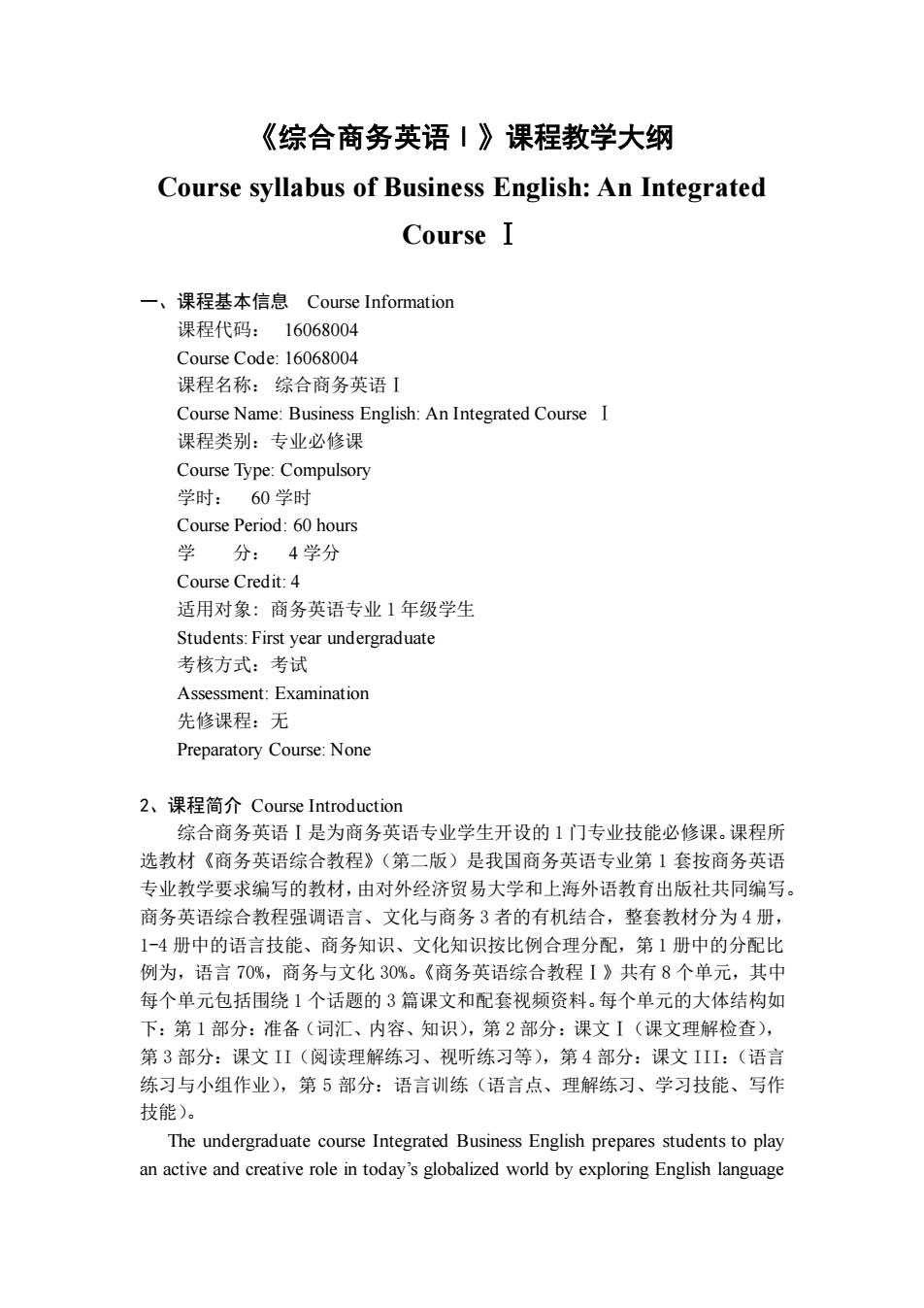
《综合商务英语丨》课程教学大纲 Course syllabus of Business English:An Integrated Course I 一、课程基本信息Course Information 课程代码: 16068004 Course Code:16068004 课程名称:综合商务英语I Course Name:Business English:An Integrated Course I 课程类别:专业必修课 Course Type:Compulsory 学时:60学时 Course Period:60 hours 学 分:4学分 Course Credit 4 适用对象:商务英语专业1年级学生 Students:First year undergraduate 考核方式:考试 Assessment:Examination 先修课程:无 Preparatory Course:None 2、课程简介Course Introduction 综合商务英语I是为商务英语专业学生开设的1门专业技能必修课。课程所 选教材《商务英语综合教程》(第二版)是我商务英语专业第1套按商务英语 专业教学要求编写的教材,由对外经济贸易大学和上海外语教育出版社共同编写。 商务英语综合教程强调语言、文化与商务3者的有机结合,整套教材分为4册, 1-4册中的语言技能、商务知识、文化知识按比例合理分配,第1册中的分配比 例为,语言70%,商务与文化30%。《商务英语综合教程I》共有8个单元,其中 每个单元包括围绕1个话题的3篇课文和配套视频资料。每个单元的大体结构如 下:第1部分:准备(词汇、内容、知识),第2部分:课文I(课文理解检查), 第3部分:课文II(阅读理解练习、视听练习等),第4部分:课文II1:(语言 练习与小组作业),第5部分:语言训练(语言点、理解练习、学习技能、写作 技能)。 The undergraduate course Integrated Business English prepares students to play an active and creative role in today's globalized world by exploring English language
《综合商务英语Ⅰ》课程教学大纲 Course syllabus of Business English: An Integrated Course Ⅰ 一、课程基本信息 Course Information 课程代码: 16068004 Course Code: 16068004 课程名称: 综合商务英语Ⅰ Course Name: Business English: An Integrated Course Ⅰ 课程类别:专业必修课 Course Type: Compulsory 学时: 60 学时 Course Period: 60 hours 学 分: 4 学分 Course Credit: 4 适用对象: 商务英语专业 1 年级学生 Students: First year undergraduate 考核方式:考试 Assessment: Examination 先修课程:无 Preparatory Course: None 2、课程简介 Course Introduction 综合商务英语Ⅰ是为商务英语专业学生开设的 1 门专业技能必修课。课程所 选教材《商务英语综合教程》(第二版)是我国商务英语专业第 1 套按商务英语 专业教学要求编写的教材,由对外经济贸易大学和上海外语教育出版社共同编写。 商务英语综合教程强调语言、文化与商务 3 者的有机结合,整套教材分为 4 册, 1-4 册中的语言技能、商务知识、文化知识按比例合理分配,第 1 册中的分配比 例为,语言 70%,商务与文化 30%。《商务英语综合教程Ⅰ》共有 8 个单元,其中 每个单元包括围绕 1 个话题的 3 篇课文和配套视频资料。每个单元的大体结构如 下:第 1 部分:准备(词汇、内容、知识),第 2 部分:课文Ⅰ(课文理解检查), 第 3 部分:课文 II(阅读理解练习、视听练习等),第 4 部分:课文 III:(语言 练习与小组作业),第 5 部分:语言训练(语言点、理解练习、学习技能、写作 技能)。 The undergraduate course Integrated Business English prepares students to play an active and creative role in today’s globalized world by exploring English language
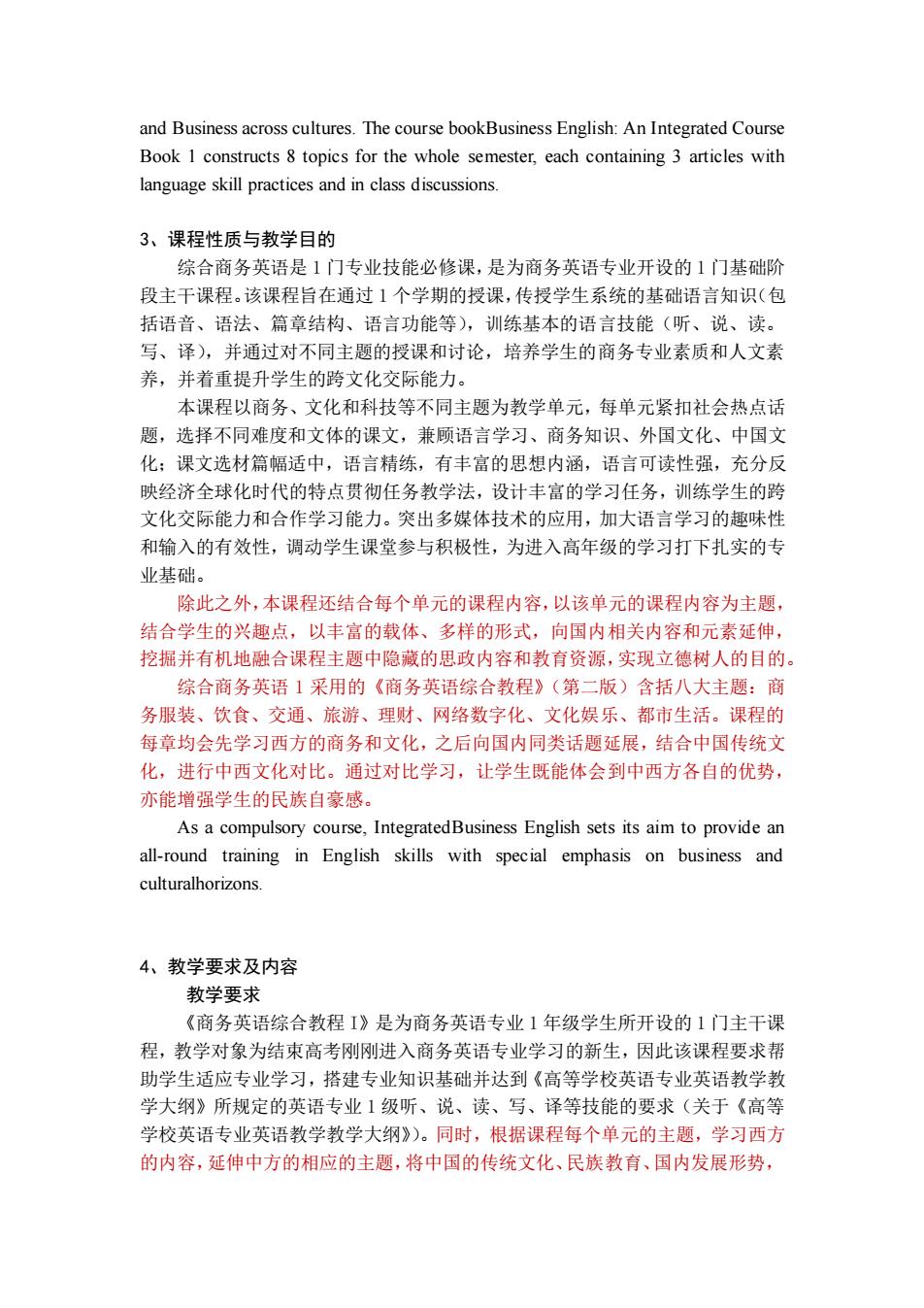
and Business across cultures.The course bookBusiness English:An Integrated Course Book I constructs 8 topics for the whole semester.each containing 3 articles with language skill practices and in class discussions. 3、课程性质与教学目的 综合商务英语是1门专业技能必修课,是为商务英语专业开设的1门基础阶 段主干课程。该课程旨在通过1个学期的授课,传授学生系统的基础语言知识(包 括语音、语法、篇章结构、语言功能等),训练基本的语言技能(听、说、读。 写、译),并通过对不同主题的授课和讨论,培养学生的商务专业素质和人文素 养,并着重提升学生的跨文化交际能力。 本课程以商务、文化和科技等不同主题为教学单元,每单元紧扣社会热点话 颗,选择不同难度和文体的课文,兼顾语言学习、商务知识、外国文化、中国文 化:课文选材篇幅适中,语言精练,有丰富的思想内涵,语言可读性强,充分反 映经济全球化时代的特点贯彻任务教学法,设计丰富的学习任务,训练学生的跨 文化交际能力和合作学习能力。突出多媒体技术的应用,加大语言学习的趣味性 和输入的有效性,调动学生课堂参与积极性,为进入高年级的学习打下扎实的专 业基础。 除此之外,本课程还结合每个单元的课程内容,以该单元的课程内容为主题 结合学生的兴趣点,以丰富的载体、多样的形式,向国内相关内容和元素延伸, 挖掘并有机地融合课程主题中隐藏的思政内容和教育资源,实现立德树人的目的 综合商务英语1采用的《商务英语综合教程》(第二版)含括八大主题:商 务服装、饮食、交通、旅游、理财、网络数字化、文化娱乐、都市生活。课程的 每章均会先学习西方的商务和文化,之后向国内同类话题延展,结合中国传统文 化,进行中西文化对比。通过对比学习,让学生既能体会到中西方各自的优势 亦能增强学生的民族自豪感。 As a compulsory course.IntegratedBusiness English sets its aim to provide an all-round training in English skills with special emphasis on business and culturalhorizons 4、教学要求及内容 教学要求 《商务英语综合教程I》是为商务英语专业1年级学生所开设的1门主干课 程,教学对象为结束高考刚刚进入商务英语专业学习的新生,因此该课程要求帮 助学牛话应专业学习,搭建专业知识:础并达到《高等学校英语专业英语教学 学大纲》所规定的英语专业1级听、说、读、写、译等技能的要求(关于《高等 学校英语专业英语教学教学大纲》)。同时,根据课程每个单元的主题,学习西方 的内容,延伸中方的相应的主题,将中国的传统文化、民族教育、国内发展形势
and Business across cultures. The course bookBusiness English: An Integrated Course Book 1 constructs 8 topics for the whole semester, each containing 3 articles with language skill practices and in class discussions. 3、课程性质与教学目的 综合商务英语是 1 门专业技能必修课,是为商务英语专业开设的 1 门基础阶 段主干课程。该课程旨在通过 1 个学期的授课,传授学生系统的基础语言知识(包 括语音、语法、篇章结构、语言功能等),训练基本的语言技能(听、说、读。 写、译),并通过对不同主题的授课和讨论,培养学生的商务专业素质和人文素 养,并着重提升学生的跨文化交际能力。 本课程以商务、文化和科技等不同主题为教学单元,每单元紧扣社会热点话 题,选择不同难度和文体的课文,兼顾语言学习、商务知识、外国文化、中国文 化;课文选材篇幅适中,语言精练,有丰富的思想内涵,语言可读性强,充分反 映经济全球化时代的特点贯彻任务教学法,设计丰富的学习任务,训练学生的跨 文化交际能力和合作学习能力。突出多媒体技术的应用,加大语言学习的趣味性 和输入的有效性,调动学生课堂参与积极性,为进入高年级的学习打下扎实的专 业基础。 除此之外,本课程还结合每个单元的课程内容,以该单元的课程内容为主题, 结合学生的兴趣点,以丰富的载体、多样的形式,向国内相关内容和元素延伸, 挖掘并有机地融合课程主题中隐藏的思政内容和教育资源,实现立德树人的目的。 综合商务英语 1 采用的《商务英语综合教程》(第二版)含括八大主题:商 务服装、饮食、交通、旅游、理财、网络数字化、文化娱乐、都市生活。课程的 每章均会先学习西方的商务和文化,之后向国内同类话题延展,结合中国传统文 化,进行中西文化对比。通过对比学习,让学生既能体会到中西方各自的优势, 亦能增强学生的民族自豪感。 As a compulsory course, IntegratedBusiness English sets its aim to provide an all-round training in English skills with special emphasis on business and culturalhorizons. 4、教学要求及内容 教学要求 《商务英语综合教程 I》是为商务英语专业 1 年级学生所开设的 1 门主干课 程,教学对象为结束高考刚刚进入商务英语专业学习的新生,因此该课程要求帮 助学生适应专业学习,搭建专业知识基础并达到《高等学校英语专业英语教学教 学大纲》所规定的英语专业 1 级听、说、读、写、译等技能的要求(关于《高等 学校英语专业英语教学教学大纲》)。同时,根据课程每个单元的主题,学习西方 的内容,延伸中方的相应的主题,将中国的传统文化、民族教育、国内发展形势
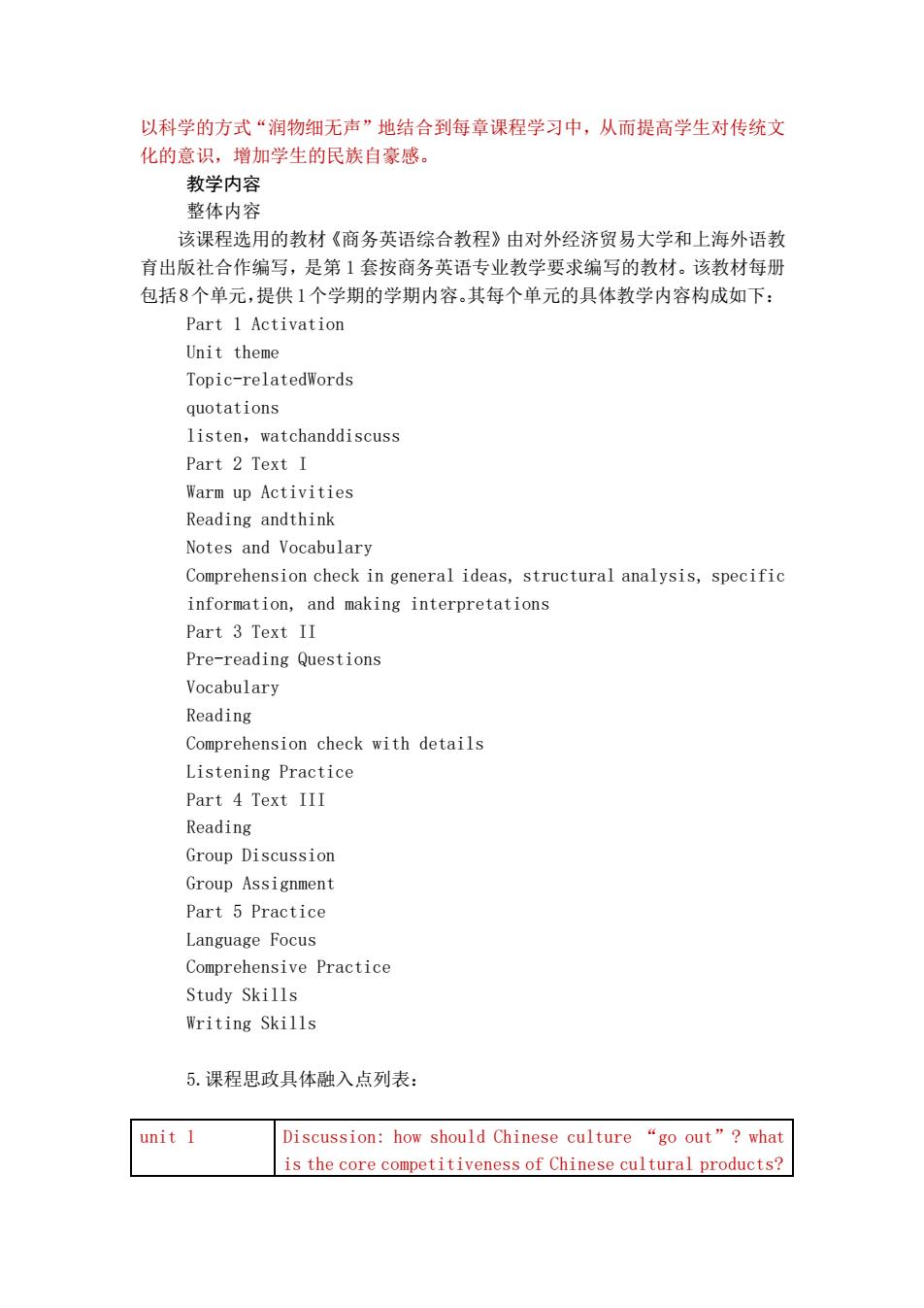
以科学的方式“润物细无声”地结合到每章课程学习中,从而提高学生对传统文 化的意识,增加学生的民族自豪感。 教学内容 整体内容 该课程选用的教材《商务英语综合教程》由对外经济贸易大学和上海外语教 育出版社合作编写,是第1套按商务英语专业教学要求编写的教材。该教材每册 包括8个单元,提供1个学期的学期内容。其每个单元的具体教学内容构成如下: Part 1 Activation Unit theme Topic-relatedWords quotations listen,watchanddiscuss Part 2 Text I Warm up Activities Reading andthink Notes and Vocabulary Comprehension check in general ideas,structural analysis,specific information,and making interpretations Part 3 Text II Pre-reading Questions Vocabulary Reading Comprehension check with details Listening Practice Part 4 Text III Reading Group Discussion Group Assignment Part 5 Practice Language Focus Comprehensive Practice Study Skills Writing Skills 5.课程思政具体融入点列表: it l Discussion:how should Chinese culture "go out"?what is the core competitiveness of Chinese cultural products?
以科学的方式“润物细无声”地结合到每章课程学习中,从而提高学生对传统文 化的意识,增加学生的民族自豪感。 教学内容 整体内容 该课程选用的教材《商务英语综合教程》由对外经济贸易大学和上海外语教 育出版社合作编写,是第 1 套按商务英语专业教学要求编写的教材。该教材每册 包括8个单元,提供 1个学期的学期内容。其每个单元的具体教学内容构成如下: Part 1 Activation Unit theme Topic-relatedWords quotations listen,watchanddiscuss Part 2 Text I Warm up Activities Reading andthink Notes and Vocabulary Comprehension check in general ideas, structural analysis, specific information, and making interpretations Part 3 Text II Pre-reading Questions Vocabulary Reading Comprehension check with details Listening Practice Part 4 Text III Reading Group Discussion Group Assignment Part 5 Practice Language Focus Comprehensive Practice Study Skills Writing Skills 5.课程思政具体融入点列表: unit 1 Discussion: how should Chinese culture “go out”? what is the core competitiveness of Chinese cultural products?
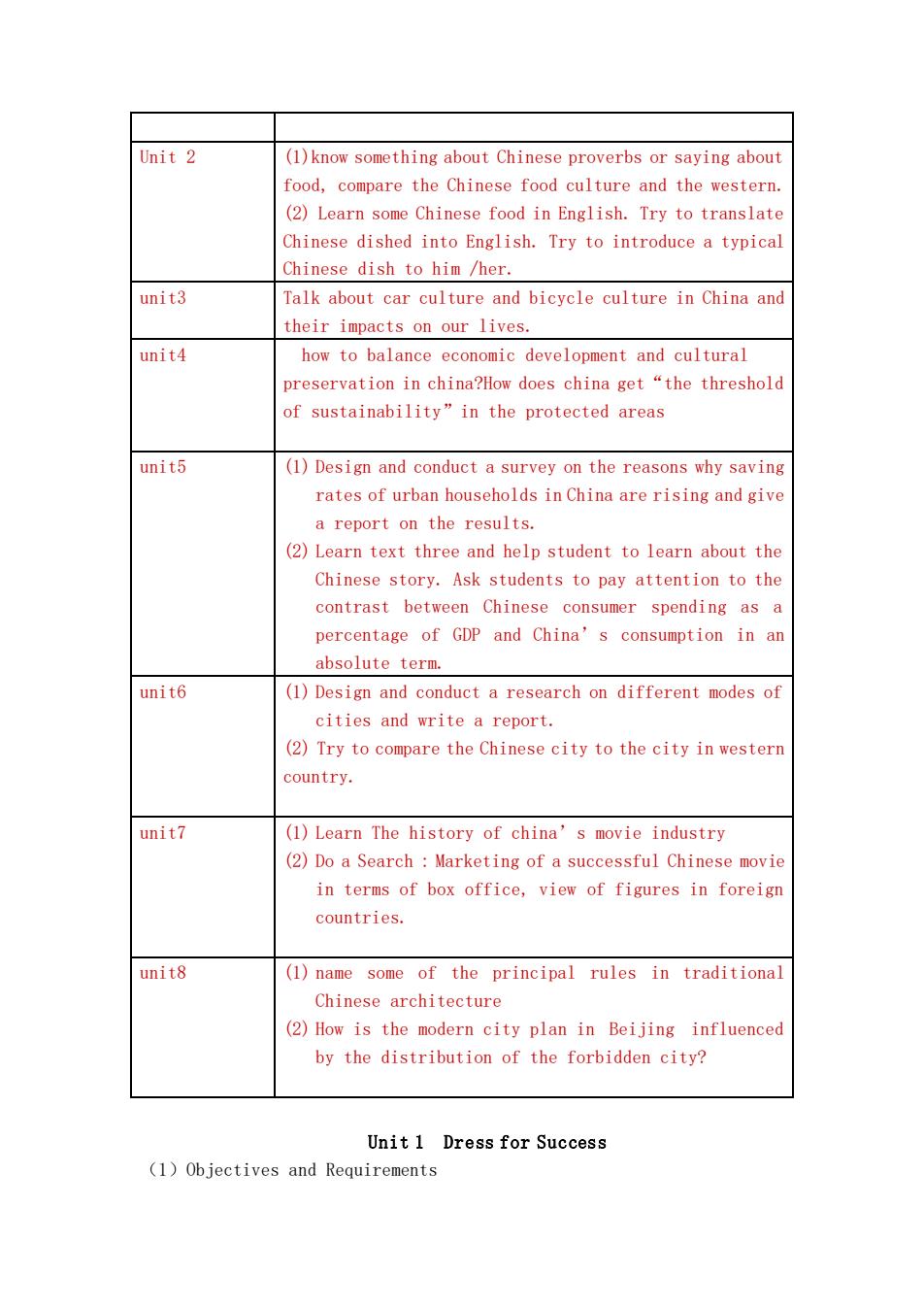
Unit 2 (1)know something about Chinese proverbs or saying about food,compare the Chinese food culture and the western (2)Learn some Chinese food in English.Try to translate Chinese dished into English.Try to introduce a typica Chinese dish to him /her. unit3 Talk about car culture and bicycle culture in China and their impacts on our lives. unit4 how to balance economic development and cultural preservation in china?How does china get "the threshold of sustainability"in the protected areas unit5 (1)Design and conduct a survey on the reasons why saving rates of urban households in China are rising and give a report on the results. (2)Learn text three and help student to learn about the Chinese story.Ask students to pay attention to the contrast between Chinese consumer spending as a percentage of GDP and China's consumption in an absolute term. unit6 (1)Design and conduct a research on different modes of cities and write a report. (2)Try to compare the Chinese city to the city in western country. unit7 (1)Learn The history of china's movie industry (2)Do a Search:Marketing of a successful Chinese movie in terms of box office.view of figures in foreign countries. unit8 (1)name some of the principal rules in traditional Chinese architecture (2)How is the modern city plan in Beijing influenced by the distribution of the forbidden city? Unit 1 Dress for Success (1)Objectives and Requirements
Unit 2 (1)know something about Chinese proverbs or saying about food, compare the Chinese food culture and the western. (2) Learn some Chinese food in English. Try to translate Chinese dished into English. Try to introduce a typical Chinese dish to him /her. unit3 Talk about car culture and bicycle culture in China and their impacts on our lives. unit4 how to balance economic development and cultural preservation in china?How does china get“the threshold of sustainability”in the protected areas unit5 (1) Design and conduct a survey on the reasons why saving rates of urban households in China are rising and give a report on the results. (2) Learn text three and help student to learn about the Chinese story. Ask students to pay attention to the contrast between Chinese consumer spending as a percentage of GDP and China’s consumption in an absolute term. unit6 (1) Design and conduct a research on different modes of cities and write a report. (2) Try to compare the Chinese city to the city in western country. unit7 (1) Learn The history of china’s movie industry (2) Do a Search : Marketing of a successful Chinese movie in terms of box office, view of figures in foreign countries. unit8 (1) name some of the principal rules in traditional Chinese architecture (2) How is the modern city plan in Beijing influenced by the distribution of the forbidden city? Unit 1 Dress for Success (1)Objectives and Requirements
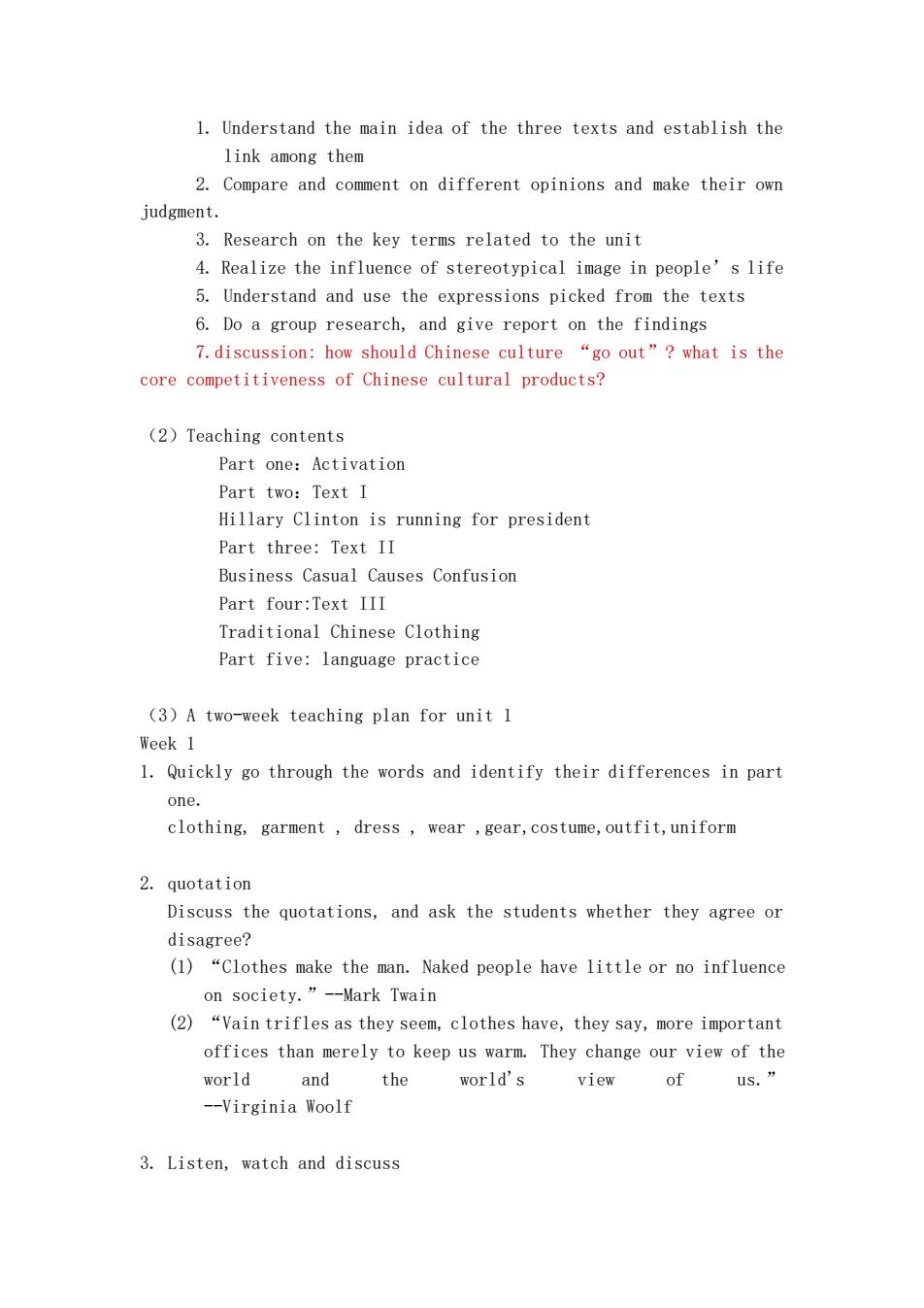
1.Understand the main idea of the three texts and establish the link among them 2.Compare and comment on different opinions and make their own judgment. 3.Research on the key terms related to the unit 4.Realize the influence of stereotypical image in people's life 5.Understand and use the expressions picked from the texts 6.Do a group research,and give report on the findings 7.discussion:how should Chinese culture "go out"?what is the core competitiveness of Chinese cultural products? (2)Teaching contents Part one:Activation Part two:Text I Hillary Clinton is running for president Part three:Text II Business Casual Causes Confusion Part four:Text III Traditional Chinese Clothing Part five:language practice (3)A two-week teaching plan for unit 1 Week 1 1.Quickly go through the words and identify their differences in part one. clothing,garment,dress,wear,gear,costume,outfit,uniform 2.quotation Discuss the quotations,and ask the students whether they agree or disagree? (1)"Clothes make the man.Naked people have little or no influence on society."--Mark Twain (2)"Vain trifles as they seem,clothes have,they say,more important offices than merely to keep us warm.They change our view of the world and the world's view of -Virginia Woolf 3.Listen,watch and discuss
1. Understand the main idea of the three texts and establish the link among them 2. Compare and comment on different opinions and make their own judgment. 3. Research on the key terms related to the unit 4. Realize the influence of stereotypical image in people’s life 5. Understand and use the expressions picked from the texts 6. Do a group research, and give report on the findings 7.discussion: how should Chinese culture “go out”? what is the core competitiveness of Chinese cultural products? (2)Teaching contents Part one:Activation Part two:Text I Hillary Clinton is running for president Part three: Text II Business Casual Causes Confusion Part four:Text III Traditional Chinese Clothing Part five: language practice (3)A two-week teaching plan for unit 1 Week 1 1. Quickly go through the words and identify their differences in part one. clothing, garment , dress , wear ,gear,costume,outfit,uniform 2. quotation Discuss the quotations, and ask the students whether they agree or disagree? (1) “Clothes make the man. Naked people have little or no influence on society.”--Mark Twain (2) “Vain trifles as they seem, clothes have, they say, more important offices than merely to keep us warm. They change our view of the world and the world's view of us.” --Virginia Woolf 3. Listen, watch and discuss
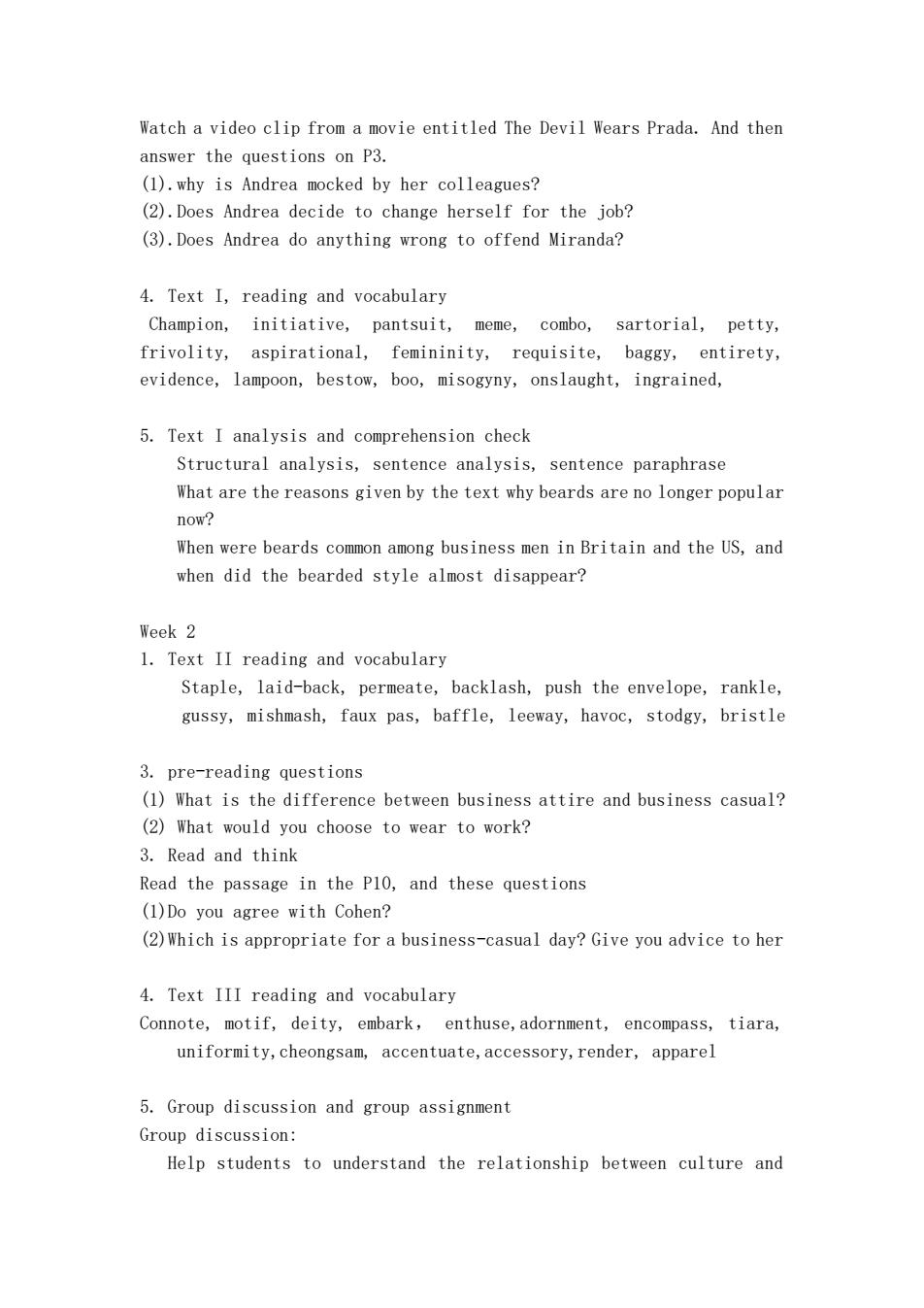
Watch a video clip from a movie entitled The Devil Wears Prada.And then answer the questions on P3. (1).why is Andrea mocked by her colleagues? (2).Does Andrea decide to change herself for the job? (3).Does Andrea do anything wrong to offend Miranda? 4.Text I,reading and vocabulary Champion,initiative,pantsuit,meme combo.sartorial.petty frivolity,aspirational,femininity,requisite,baggy,entirety, evidence,lampoon,bestow,boo,misogyny,onslaught,ingrained, 5.Text I analysis and comprehension check Structural analysis,sentence analysis,sentence paraphrase What are the reasons given by the text why beards are no longer popular now? When were beards common among business men in Britain and the US,and when did the bearded style almost disappear? Week 2 1.Text II reading and vocabulary Staple,laid-back,permeate,backlash,push the envelope,rankle, gussy,mishmash,faux pas,baffle,leeway,havoc,stodgy,bristle 3.pre-reading questions (1)What is the difference between business attire and business casual? (2)What would you choose to wear to work? 3.Read and think Read the passage in the P10,and these questions (1)Do you agree with Cohen? (2)Which is appropriate for a business-casual day?Give you advice to her 4.Text III reading and vocabulary Connote,motif,deity,embark,enthuse,adornment,encompass,tiara, uniformity,cheongsam,accentuate,accessory,render,apparel 5.Group discussion and group assignment Group discussion: Help students to understand the relationship between culture and
Watch a video clip from a movie entitled The Devil Wears Prada. And then answer the questions on P3. (1).why is Andrea mocked by her colleagues? (2).Does Andrea decide to change herself for the job? (3).Does Andrea do anything wrong to offend Miranda? 4. Text I, reading and vocabulary Champion, initiative, pantsuit, meme, combo, sartorial, petty, frivolity, aspirational, femininity, requisite, baggy, entirety, evidence, lampoon, bestow, boo, misogyny, onslaught, ingrained, 5. Text I analysis and comprehension check Structural analysis, sentence analysis, sentence paraphrase What are the reasons given by the text why beards are no longer popular now? When were beards common among business men in Britain and the US, and when did the bearded style almost disappear? Week 2 1. Text II reading and vocabulary Staple, laid-back, permeate, backlash, push the envelope, rankle, gussy, mishmash, faux pas, baffle, leeway, havoc, stodgy, bristle 3. pre-reading questions (1) What is the difference between business attire and business casual? (2) What would you choose to wear to work? 3. Read and think Read the passage in the P10, and these questions (1)Do you agree with Cohen? (2)Which is appropriate for a business-casual day? Give you advice to her 4. Text III reading and vocabulary Connote, motif, deity, embark, enthuse,adornment, encompass, tiara, uniformity,cheongsam, accentuate,accessory,render, apparel 5. Group discussion and group assignment Group discussion: Help students to understand the relationship between culture and
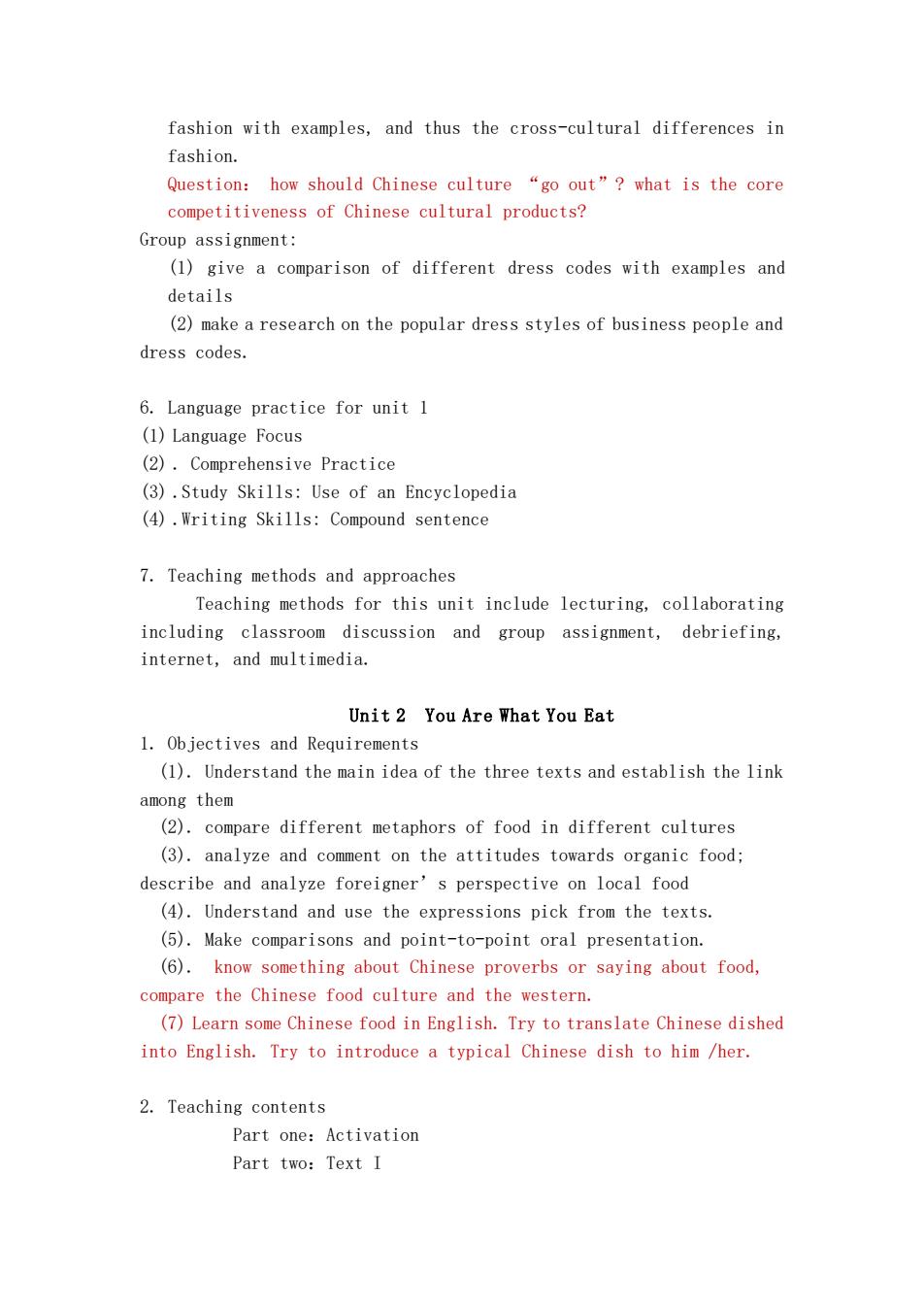
fashion with examples,and thus the cross-cultural differences in fashion. Question:how should Chinese culture "go out"?what is the core competitiveness of Chinese cultural products? Group assignment: (1)give a comparison of different dress codes with examples and details (2)make a research on the popular dress styles of business people and dress codes. 6.Language practice for unit 1 (1)Language Focus (2).Comprehensive Practice (3).Study Skills:Use of an Encyclopedia (4).Writing Skills:Compound sentence 7.Teaching methods and approaches Teaching methods for this unit include lecturing,collaborating including classroom discussion and group assignment,debriefing, internet,and multimedia. Unit 2 You Are What You Eat 1.Objectives and Requirements (1).Understand the main idea of the three texts and establish the link among them (2).compare different metaphors of food in different cultures (3).analyze and comment on the attitudes towards organic food; describe and analyze foreigner's perspective on local food (4).Understand and use the expressions pick from the texts. (5).Make comparisons and point-to-point oral presentation. (6).know something about Chinese proverbs or saying about food, compare the Chinese food culture and the western. (7)Learn some Chinese food in English.Try to translate Chinese dished into English.Try to introduce a typical Chinese dish to him /her. 2.Teaching contents Part one:Activation Part two:Text I
fashion with examples, and thus the cross-cultural differences in fashion. Question: how should Chinese culture “go out”? what is the core competitiveness of Chinese cultural products? Group assignment: (1) give a comparison of different dress codes with examples and details (2) make a research on the popular dress styles of business people and dress codes. 6. Language practice for unit 1 (1) Language Focus (2) . Comprehensive Practice (3) .Study Skills: Use of an Encyclopedia (4) .Writing Skills: Compound sentence 7. Teaching methods and approaches Teaching methods for this unit include lecturing, collaborating including classroom discussion and group assignment, debriefing, internet, and multimedia. Unit 2 You Are What You Eat 1. Objectives and Requirements (1). Understand the main idea of the three texts and establish the link among them (2). compare different metaphors of food in different cultures (3). analyze and comment on the attitudes towards organic food; describe and analyze foreigner’s perspective on local food (4). Understand and use the expressions pick from the texts. (5). Make comparisons and point-to-point oral presentation. (6). know something about Chinese proverbs or saying about food, compare the Chinese food culture and the western. (7) Learn some Chinese food in English. Try to translate Chinese dished into English. Try to introduce a typical Chinese dish to him /her. 2. Teaching contents Part one:Activation Part two:Text I
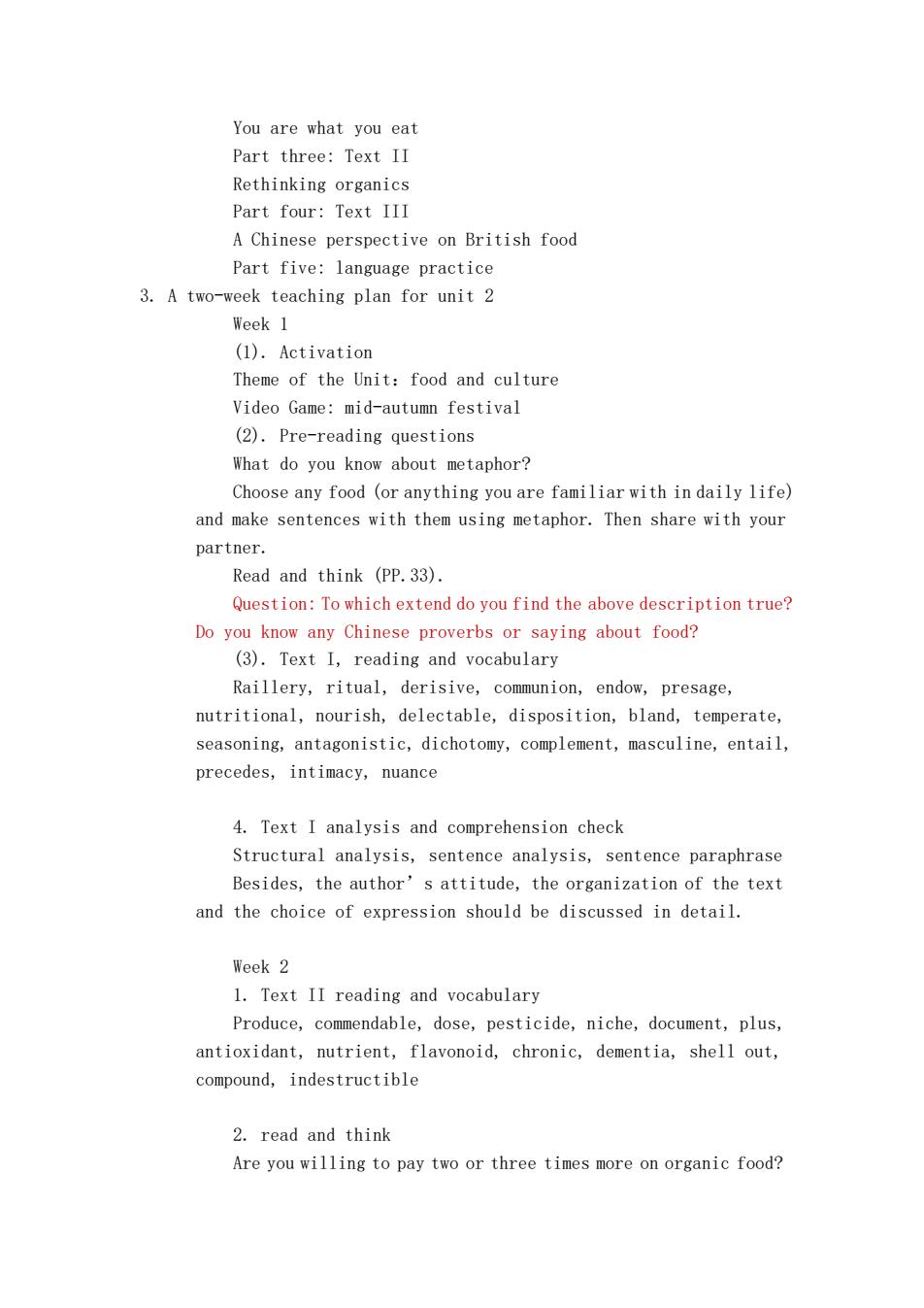
You are what you eat Part three:Text II Rethinking organics Part four:Text III A Chinese perspective on British food Part five:language practice 3.A two-week teaching plan for unit 2 Week I (1).Activation Theme of the Unit:food and culture Video Game:mid-autumn festival (2).Pre-reading questions What do you know about metaphor? Choose any food (or anything you are familiar with in daily life) and make sentences with them using metaphor.Then share with your partner. Read and think (PP.33). Question:To which extend do you find the above description true? Do you know any Chinese proverbs or saying about food? (3).Text I,reading and vocabulary Raillery,ritual,derisive,communion,endow,presage, nutritional,nourish,delectable,disposition,bland,temperate, seasoning,antagonistic,dichotomy,complement,masculine,entail, precedes,intimacy,nuance 4.Text I analysis and comprehension check Structural analysis,sentence analysis,sentence paraphrase Besides,the author's attitude,the organization of the text and the choice of expression should be discussed in detail. Week 2 1.Text II reading and vocabulary Produce,commendable,dose,pesticide,niche,document,plus, antioxidant,nutrient,flavonoid,chronic,dementia,shell out, compound,indestructible 2.read and think Are you willing to pay two or three times more on organic food?
You are what you eat Part three: Text II Rethinking organics Part four: Text III A Chinese perspective on British food Part five: language practice 3. A two-week teaching plan for unit 2 Week 1 (1). Activation Theme of the Unit:food and culture Video Game: mid-autumn festival (2). Pre-reading questions What do you know about metaphor? Choose any food (or anything you are familiar with in daily life) and make sentences with them using metaphor. Then share with your partner. Read and think (PP.33). Question: To which extend do you find the above description true? Do you know any Chinese proverbs or saying about food? (3). Text I, reading and vocabulary Raillery, ritual, derisive, communion, endow, presage, nutritional, nourish, delectable, disposition, bland, temperate, seasoning, antagonistic, dichotomy, complement, masculine, entail, precedes, intimacy, nuance 4. Text I analysis and comprehension check Structural analysis, sentence analysis, sentence paraphrase Besides, the author’s attitude, the organization of the text and the choice of expression should be discussed in detail. Week 2 1. Text II reading and vocabulary Produce, commendable, dose, pesticide, niche, document, plus, antioxidant, nutrient, flavonoid, chronic, dementia, shell out, compound, indestructible 2. read and think Are you willing to pay two or three times more on organic food?
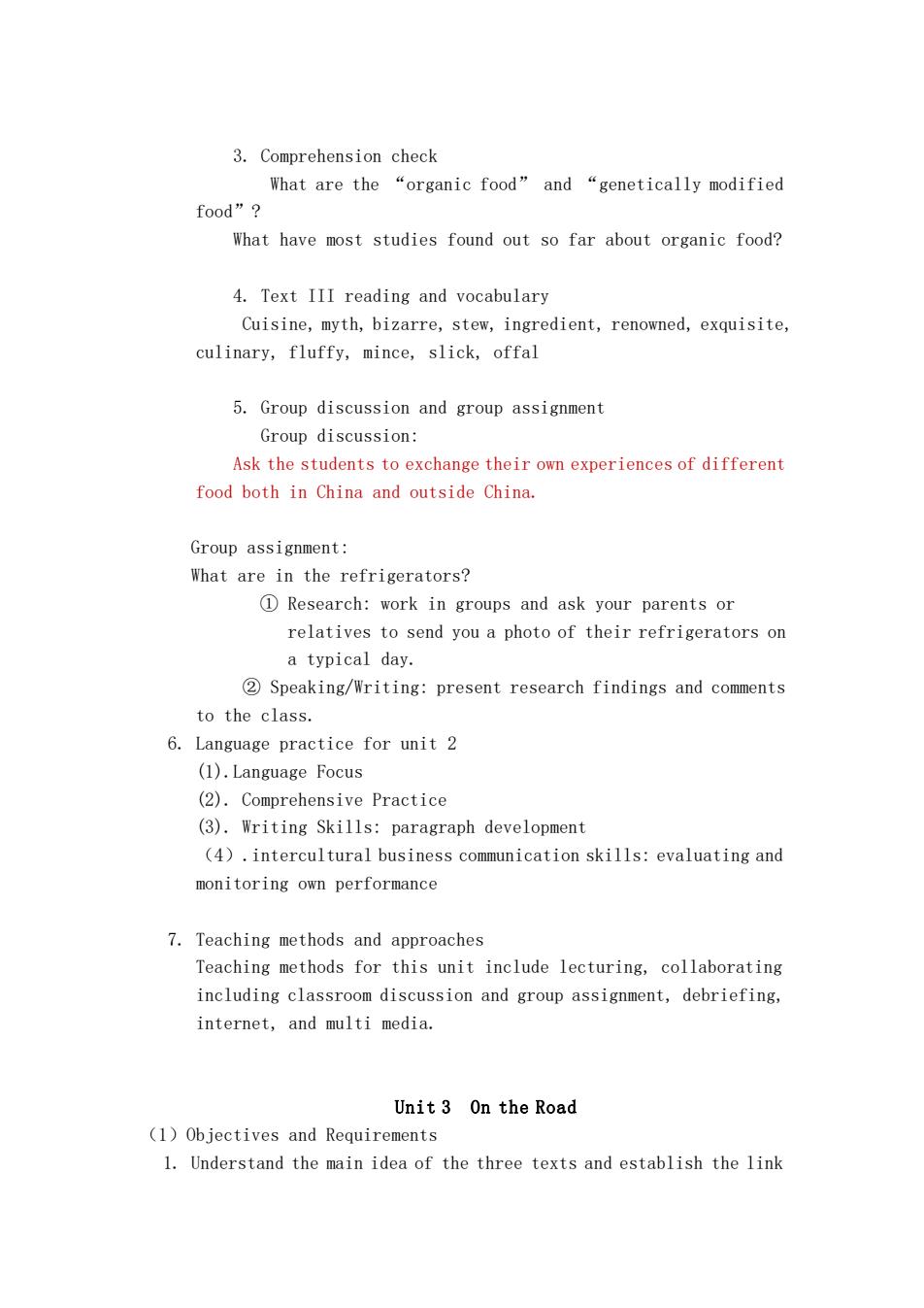
3.Comprehension check What are the“organic food”and“genetically modified food”? What have most studies found out so far about organic food? 4.Text III reading and vocabulary Cuisine,myth,bizarre,stew,ingredient,renowned,exquisite, culinary,fluffy,mince,slick,offal 5.Group discussion and group assignment Group discussion: Ask the students to exchange their own experiences of different food both in china and outside china. Group assignment: What are in the refrigerators? 1 Research:work in groups and ask your parents or relatives to send you a photo of their refrigerators on a typical day. 2 Speaking/Writing:present research findings and comments to the class. 6.Language practice for unit 2 (1).Language Focus (2).Comprehensive Practice (3).Writing Skills:paragraph development (4).intercultural business communication skills:evaluating and monitoring own performance 7.Teaching methods and approaches Teaching methods for this unit include lecturing,collaborating including classroom discussion and group assignment,debriefing, internet,and multi media. Unit 3 On the Road (1)Objectives and Requirements 1.Understand the main idea of the three texts and establish the link
3. Comprehension check What are the “organic food” and “genetically modified food”? What have most studies found out so far about organic food? 4. Text III reading and vocabulary Cuisine, myth, bizarre, stew, ingredient, renowned, exquisite, culinary, fluffy, mince, slick, offal 5. Group discussion and group assignment Group discussion: Ask the students to exchange their own experiences of different food both in China and outside China. Group assignment: What are in the refrigerators? ① Research: work in groups and ask your parents or relatives to send you a photo of their refrigerators on a typical day. ② Speaking/Writing: present research findings and comments to the class. 6. Language practice for unit 2 (1).Language Focus (2). Comprehensive Practice (3). Writing Skills: paragraph development (4).intercultural business communication skills: evaluating and monitoring own performance 7. Teaching methods and approaches Teaching methods for this unit include lecturing, collaborating including classroom discussion and group assignment, debriefing, internet, and multi media. Unit 3 On the Road (1)Objectives and Requirements 1. Understand the main idea of the three texts and establish the link

among them 2.Have a primary understanding of roles played by the rail,the car and the bicycle respectively in transport system. 3.Talk about car culture and bicycle culture in China and their impacts on our lives. 4.Understand and use the expressions pick from the texts. 5.Make comparisons and point-to-point oral presentation. (2)Teaching contents Part one:Activation Part two:Text I Letter from America:Notes from the underground Part three:Text II Redesigning Cities for People Part four:Text III Cycles,China's Icon,Are Ubiquitous despite Car Invasion Part five:language practice (3)A two-week teaching plan for unit 3 Week 1 1.Activation Theme of the Unit:Transportation Video Game:Who Is to Arrive First? 2.Pre-reading questions Does your hometown have subway?If yes,what is it like?Does it make for comfortable traveling? If no,why is there no subway?Summarize your idea with additional markers like"first,second,and thento make your points clear. Watch the video clip"Metro service"and take notes to answer question.What are the features of the subway? 3.Text I,reading and vocabulary notorious, economical,dilemma, ambivalent, unreliable, incomprehensible,paralyze,randomly,mugging,graffiti,indictment swear by,borough,entail,upwards of,warren,hauling,accomplice, pathology,glimpse,well-heeled,straphanger,epitomize 4.Text I analysis and comprehension check Structural analysis,sentence analysis,sentence paraphrase Is the author a native New Yorker?
among them 2. Have a primary understanding of roles played by the rail, the car and the bicycle respectively in transport system. 3. Talk about car culture and bicycle culture in China and their impacts on our lives. 4. Understand and use the expressions pick from the texts. 5. Make comparisons and point-to-point oral presentation. (2)Teaching contents Part one:Activation Part two:Text I Letter from America: Notes from the underground Part three: Text II Redesigning Cities for People Part four:Text III Cycles, China’s Icon, Are Ubiquitous despite Car Invasion Part five: language practice (3)A two-week teaching plan for unit 3 Week 1 1. Activation Theme of the Unit:Transportation Video Game: Who Is to Arrive First? 2. Pre-reading questions Does your hometown have subway? If yes, what is it like? Does it make for comfortable traveling? If no, why is there no subway? Summarize your idea with additional markers like "first, second, and then …" to make your points clear. Watch the video clip “Metro Service” and take notes to answer question. What are the features of the subway? 3. Text I, reading and vocabulary notorious, economical, dilemma, ambivalent, unreliable, incomprehensible, paralyze, randomly, mugging, graffiti, indictment swear by, borough, entail, upwards of, warren, hauling, accomplice, pathology, glimpse, well-heeled, straphanger, epitomize 4. Text I analysis and comprehension check Structural analysis, sentence analysis, sentence paraphrase Is the author a native New Yorker?